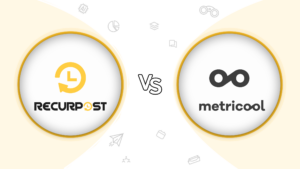Loomly vs SocialPilot
Loomly vs SocialPilot – Which Platform Is Better in 2025?
Which tool is the best? Is it that hard to decide?
If you're stuck between Loomly and SocialPilot, you're not alone. Both offer great features, but the right choice depends on your needs.
No credit card required

Quick Summary: Loomly and SocialPilot
When deciding on the perfect social media management tool, certain aspects, such as features, pricing, reviews, and support, must be evaluated.
Here is the overview of tools:
2 months free with annual billing
Loomly Overview
Loomly positions itself as the collaborative brand success platform designed specifically for marketing teams that value seamless workflow management and creative excellence. Loomly has grown from solving their own agency’s collaboration challenges to serving over 7,000 customers globally with $5M+ in annual recurring revenue.
What distinguishes Loomly is its focus on brand success rather than just social media posting. The platform provides over 300 content ideas, post mockups for approval, and advanced collaboration features that ensure every piece of content aligns with brand messaging before publication. For marketing teams seeking a platform that enhances creativity while maintaining professional standards, Loomly offers the perfect balance of structure and flexibility.
The content creation and collaboration features are well-received by users. While Loomly performs well for most platforms, there is feedback suggesting a desire for broader channel support and deeper automation options. [Capterra]
Users consistently praise this software for its clean interface and ease of use. It is especially favored by beginners and small teams looking for a straightforward tool. However, some users sentiments suggest that the analytics and integration capabilities are a bit limited compared to more advanced platforms. [G2]
SocialPilot Overview
SocialPilot social media tool has established itself as the preferred choice for agencies and growing businesses that prioritize scalability and comprehensive functionality. Trusted by 15,000+ customers worldwide, this platform has facilitated the publication of over 5 billion posts, demonstrating its capacity to handle enterprise-level social media operations.
The platform’s strength lies in its enterprise-grade capabilities delivered through an intuitive interface, making it accessible to both small teams and large organizations focused on removing friction from social media management while providing the depth of features that growing businesses require.
Capterra reviewers highlight SocialPilot’s ease of use, budget-friendly plans, and effective team collaboration. Bulk scheduling is highly valued. Minor drawbacks include fewer automation features, but overall, it’s seen as reliable and efficient. [Capterra]
Users appreciate SocialPilot’s affordability, simple scheduling, and client management. Reviews highlight bulk posting, reliable publishing, and white-label reporting. Some note limited integrations compared to larger platforms, but overall value remains excellent. [G2]
Rating Comparison
Feature Comparison: Loomly vs SocialPilot
Features
Scheduling & Publishing
Schedule posts with platform previews, optimization tips, and visual content calendar.
Bulk scheduling, repeat posts, and visual calendar with time slots for each platform.
AI-powered scheduler recycles evergreen content, auto-schedules posts, and suggests best times to publish.
Engagement
Reply to comments and messages; no unified inbox across all networks.
Social inbox supports replies for Facebook, Instagram, and LinkedIn with message filtering.
Unified inbox helps reply faster; smart filters prioritize conversations that need attention.
Collaboration
Approval workflows, comments, and team roles for content review and coordination.
Team collaboration with role-based access, content approvals, and shared calendars.
Shared workspaces and approval flows keep teams aligned with role-based access and smart task routing.
Analytics
Custom reports, post performance metrics, and white-label dashboards for agencies.
Downloadable, white-label reports with platform-wise performance and engagement metrics.
Smart analytics track engagement, reach, and clicks; white-label reports simplify client performance tracking.
AI Features
AI suggests post ideas, ideal times, and content improvements for higher engagement.
AI Assistant creates captions, recommends hashtags, and suggests peak posting times.
Generates captions, hashtags, bios, and post ideas; predicts performance; automates scheduling and reports.
Pros & Cons: Loomly and SocialPilot
Pros
- Clean and simple interface
- Excellent customer support
Cons
- Creates too many browser tabs when duplicating posts
- Occasionally, need to reconnect social accounts.
Pros
- User-friendly drag-and-drop calendar
- Detailed analytics and reporting tools
Cons
- Outdated interface design feels less modern
- Limited Instagram features for direct publishing
Pricing Comparison
Starter
12 social accounts, Post ideas, Hashtag suggestions
Professional
7 social accounts, 500 AI Credits, Best Time to Post
Starter
2 social profiles, 10 daily posts, 5 recurring time slots
Beyond
60 social accounts, Custom workflows, Scheduled reports
Standard
15 social accounts, 1000 AI Credits, Best Time to Post
Personal
5 social profiles, 20 daily posts, 10 recurring time slots
Premium
25 social accounts, 5000 AI Credits, Best Time to Post
Agency
20 social profiles, 80 daily posts, 40 recurring time slots
Why RecurPost Stands Out
When comparing Loomly vs SocialPilot, you’ll quickly realize that RecurPost is the more intelligent choice once you’ve used it practically. Unlike other tools, RecurPost saves you 6–8 hours weekly with intelligent content recycling, AI-powered scheduling, and unified inbox management, delivering up to 32% higher engagement rates while managing over 100,000+ businesses across 163+ countries.
RecurPost transforms how you handle social campaigns by focusing on efficiency. While Loomly or SocialPilot often require constant content creation, RecurPost’s evergreen content library automatically recycles your top-performing posts at the best times. Its advanced AI scheduling engine ensures optimal posting windows for every network, consistently delivering 11–18% more impressions compared to manual publishing.
The platform excels in automation by eliminating repetitive tasks. Its unified social inbox consolidates all your messages across platforms, cutting response time nearly in half—from 8 hours to 4.8 hours weekly. Plus, RecurPost detects and fixes 850+ post-breaking glitches automatically, guaranteeing your content always publishes on time.
If you’re searching for Loomly and SocialPilot alternatives, RecurPost stands out as the clear winner with unmatched automation intelligence, time savings, and ROI.
Why RecurPost is better!
RecurPost isn’t just an alternative to Loomly and SocialPilot – it’s a smarter choice for businesses that want more functionality at a lower cost.






